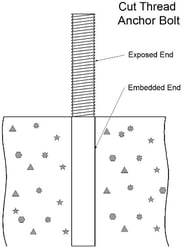For any product manufactured from stainless steel, it is important to consider if it will be visible in the finished assembly. This is especially true for Anchor Bolts, Turnbuckle Rods and Clevis Rod Assemblies. If so, the fabricator should know that to prevent rust from appearing on the surface, the item should be passivated after all fabricating and machining is complete.
Stainless Steel in itself will not rust, however, during the manufacturing and rolling processes, the surface will become impregnated with particles of carbon steel. These particles will oxidize when exposed to the elements. This is called Rouging. While it changes, the appearance it is not affecting the steel.
It should be noted while anchor bolts are often made from stainless steel, usually grade 303/304, 316 or 316L, they will not qualify as F1554. The ASTM Specification F 1554, which covers all the manufacturing requirements for Anchor Bolts, clearly states that three grades of steel can be made from all carbon steels: Grade A-36, Grade 55 and Grade A-105.
 In the case of a stainless steel anchor bolt, consider there may be no value in passivating, depending on
In the case of a stainless steel anchor bolt, consider there may be no value in passivating, depending on
the threading system used. Starting out as round bar, the section of the bolt where the surface remains untouched is usually going to be embedded in concrete and hence, not visible. The exposed end is usually threaded. If the threads are “cut”, the surface of the steel round bar will be removed and the contaminants along with it, removing the chance of rouging. If the threads are “rolled”, the surface remains intact along with the contaminants and will most likely show rust over time.
On the other hand, Stainless Steel Turnbuckle and Clevis Rod Assemblies, when installed and the structure is completed, are usually visible. In some applications, this is not the case, such as food processing and waste water treatment facilities, where stainless steel is used to protect against contamination and corrosion, rather than for the esthetic appeal. In the event that the assembly will be visible, passivating is highly recommended. It is also critical to passivate all the hardware such as turnbuckles, clevises and clevis pins.




